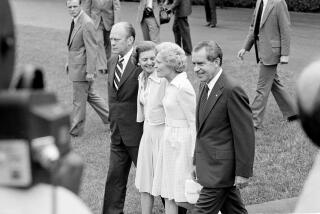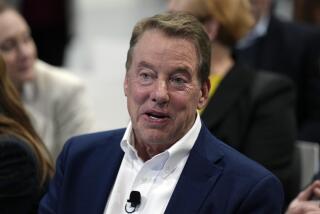But Is There a Future in Ford?
- Share via
Ford Motor Co. was sputtering badly at the end of World War II. But it managed to come roaring back as founder Henry Ford’s grandson, Henry II, took over the company and rallied it under the slogan “There’s a Ford in Your Future.”
The question now is whether William Clay “Bill” Ford Jr., great-grandson of the original Henry and nephew of Henry II, can bring the company back once again.
Some doubt it. As Ford celebrates its 100th anniversary this year, a few skeptics are wondering whether Ford will make it to see its 105th -- at least as an independent concern.
“I’m really not sure that Billy Ford is wise enough or experienced enough to pull the company through,” says one industry consultant.
For his part, Bill Ford has committed himself to returning the company to profitability after it piled up more than $5 billion in losses in 2002, the year after he dismissed Chief Executive Jacques Nasser.
Nasser, who boasted that he would make Ford “a consumer company that happens to provide automotive products and services,” led the auto giant into a wilderness of experiments with Internet commerce and purchases of metal-salvage and car-repair operations that wound up bleeding billions of dollars.
As a result, Bill Ford has had to embark on a back-to-basics “revitalization” plan to slash costs by $1 billion while bringing out 20 new or rejuvenated vehicles. His stated aim: to earn $7 billion in pretax profit by 2007.
“We have come back from adversity many times before,” Ford says repeatedly in speeches. “We’re going to do it again.”
Can Ford, has degrees from Princeton and MIT, really live up to such a blithe prediction? The answer is yes -- but it won’t be easy.
For starters, the 45-year-old Ford faces a tougher business climate than did either his great-grandfather or his uncle. The global auto business is burdened by severe overcapacity. It is capable of producing about 55 million cars a year but can sell only about 32 million. Huge potential markets in Asia, Eastern Europe and Latin America remain underdeveloped.
The only way for a company to distinguish itself in such a crowded field is to bring out something truly eye-catching.
“If companies can’t develop new products, they are doomed,” says J. Ferron, senior analyst at PricewaterhouseCoopers’ Detroit-based automotive consulting practice.
One piece of Ford’s strategy is to have its Premier Automotive Group of expensive brand names -- Lincoln, Jaguar, Land Rover and Volvo -- give it a worldwide presence. It hopes that the unit will account for fully one-third of its profit four years from now.
But the Premier group is losing money because Ford has not made the production of its high-end vehicles economical with interchangeable platforms and parts -- just the kind of failing that would rankle old Henry Ford. Indeed, he pioneered the idea of interchangeable parts and processes, as he wrote in his 1926 book “Today and Tomorrow”: “About 90% of our equipment is standard so that a man on the assembly line in Detroit can step into the line at Oklahoma City or Sao Paulo, Brazil.”
Ford also may be avoiding some hard decisions. For example, it is planning to bring out new models of its Mercury brand, which has slipped to a mere 1.5% of the U.S. market. But analyst Scott Hill of Sanford C. Bernstein & Co., a New York research firm, calls the Mercury decision a “waste of time.” Ford could save $250 million, he says, by shuttering Mercury and devoting its energies to improving Volvo, Land Rover and Jaguar.
Room to Maneuver
Yet despite all the challenges, Bill Ford still has some things going for him.
The company is sitting on more than $26 billion in cash and liquid assets, giving it the ability -- assuming it straightens out its bottom line quickly enough -- to unveil new and renewed models.
This year, for instance, it will introduce a new version of its F-150 truck, a highly profitable vehicle for the company. And the light-truck sector is one in which Detroit consultants expect Ford to do well in the next five years. Next year, the company expects to roll out a mid-size sedan to replace the Taurus and a combination car-and-sport utility vehicle.
Most important, it has begun fixing the kind of quality missteps that hurt the Ford Focus and the new Thunderbird in the late 1990s.
‘Stage is Set’
Finally, it’s useful to remember that car companies often move in cycles, where they veer off track and then, as Hill puts it, “restructure to get back to normal earning power.”
Just five years ago, Ford was hailed by Wall Street as the comer that would surpass General Motors Corp. as the U.S. profit leader. Today GM is being hailed for its own recovery.
Bill Ford insists that “the stage is set for a return to greatness” at his company.
But the truth is -- with the stock down 85% in the last two years and Toyota Motor Co. close to overtaking Ford as the top brand name in the U.S. market -- he may be happy if there simply is a Ford in the future.
*
James Flanigan can be reached at jim.flanigan@ latimes.com.






